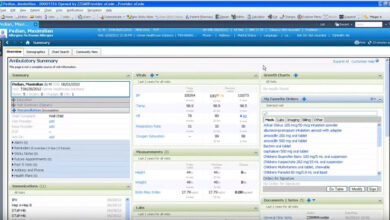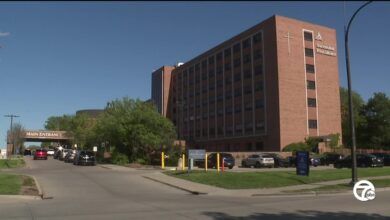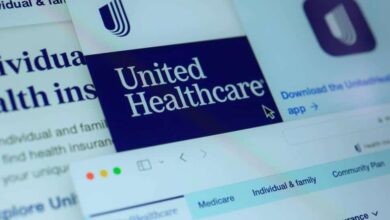
Healthcare Cybersecurity Still Has Room to Improve Safety
Healthcare cybersecurity still has room to improve safety. We live in a digital age where our health data is increasingly vulnerable. From routine doctor’s appointments to complex surgeries, our personal information is constantly being collected and stored electronically. This makes the healthcare industry a prime target for cybercriminals seeking to exploit weaknesses in security systems for financial gain or to cause disruption.
This post explores the current state of healthcare cybersecurity, highlighting its vulnerabilities and exploring potential solutions to enhance patient data protection.
The sheer volume of sensitive data held by healthcare providers—patient records, insurance information, financial details—makes a successful cyberattack incredibly damaging. Not only is patient privacy at stake, but the disruption of services can have life-threatening consequences. We’ll delve into the human element, technological shortcomings, and regulatory challenges, offering insights into how we can build a more secure and resilient healthcare ecosystem.
The Current State of Healthcare Cybersecurity
The healthcare industry faces a unique and increasingly perilous cybersecurity landscape. The convergence of sensitive patient data, complex interconnected systems, and often limited cybersecurity budgets creates a perfect storm for cyberattacks. Understanding the current threats and vulnerabilities is crucial for improving the safety and security of patient information and the overall functionality of healthcare organizations.
Cybersecurity Threats Facing Healthcare
Healthcare organizations are targeted by a wide range of sophisticated cyberattacks, motivated by financial gain, espionage, or even disruption of services. These threats are constantly evolving, requiring proactive and adaptive security measures. The sheer volume and variety of attacks necessitate a multi-layered approach to cybersecurity.
Prevalent Types of Cyberattacks
Ransomware attacks remain a significant threat, crippling hospital operations and demanding hefty ransoms for data recovery. Phishing attacks, exploiting human error, remain incredibly effective in gaining initial access to systems. Data breaches, often resulting from exploited vulnerabilities or insider threats, lead to the exposure of sensitive patient information. Denial-of-service (DoS) attacks can disrupt essential services, impacting patient care directly.
Finally, insider threats, whether malicious or accidental, pose a constant risk to data security.
Vulnerabilities in Healthcare Systems
Several factors contribute to the vulnerability of healthcare systems. The legacy systems often in use are outdated and lack the security features of modern technologies, creating significant attack surfaces. The interconnected nature of healthcare networks, while beneficial for patient care, also expands the potential impact of a successful breach. Furthermore, a shortage of skilled cybersecurity professionals often leaves organizations understaffed and struggling to keep up with evolving threats.
The high value of patient data makes healthcare a lucrative target for cybercriminals.
Healthcare cybersecurity is a constant battle, and while advancements are made, there’s always room for improvement. The recent news about adventhealth ceo retire terry shaw highlights the importance of strong leadership in navigating these complex challenges, especially as healthcare systems become increasingly reliant on technology. Ultimately, robust security measures remain crucial for protecting patient data and ensuring the ongoing safety and stability of our healthcare infrastructure.
Examples of Significant Healthcare Data Breaches
The consequences of healthcare data breaches can be devastating, ranging from financial losses and reputational damage to legal penalties and erosion of patient trust. Here are some notable examples:
| Breach | Date | Affected Entities | Impact |
|---|---|---|---|
| Anthem Data Breach | 2015 | Anthem Inc. (health insurance provider) | Compromised personal information of approximately 79 million individuals, including names, addresses, social security numbers, and health information. Resulted in significant financial losses and legal settlements. |
| Premera Blue Cross Data Breach | 2015 | Premera Blue Cross (health insurance provider) | Affected approximately 11 million individuals, exposing personal and medical information. Led to substantial financial costs and reputational damage. |
| University of Vermont Health Network Breach | 2020 | University of Vermont Health Network (hospital system) | Exposed personal information of nearly 1.3 million patients. The breach disrupted operations and resulted in significant financial and reputational costs. |
| Medibank Data Breach | 2022 | Medibank (Australian health insurer) | Compromised personal and health information of nearly 10 million customers. The breach resulted in significant financial losses, reputational damage, and regulatory scrutiny. |
| Note: This table represents a small sample of significant breaches. Numerous other incidents have occurred, highlighting the ongoing challenge of healthcare cybersecurity. | |||
Weaknesses in Existing Security Measures
Healthcare cybersecurity, while improving, still faces significant weaknesses. The complex interplay of legacy systems, budgetary constraints, and a shortage of skilled professionals creates a challenging environment ripe for exploitation. This section delves into the specific shortcomings hindering the sector’s progress towards robust and reliable security.The current state of healthcare cybersecurity is hampered by a number of interconnected factors.
Outdated infrastructure, a lack of comprehensive security protocols, and insufficient employee training all contribute to a vulnerable landscape. The interconnected nature of healthcare systems, with various devices and systems exchanging sensitive patient data, exacerbates the problem, creating numerous potential entry points for cyberattacks. This interconnectedness, while beneficial for patient care, also creates a complex web of vulnerabilities that are difficult to manage effectively.
Legacy Systems and Interoperability Challenges
Many healthcare organizations still rely on outdated systems and technologies that lack modern security features. These legacy systems often lack the patching and updating mechanisms needed to address newly discovered vulnerabilities. Furthermore, the integration of these legacy systems with newer, more secure technologies is often challenging, creating gaps in overall security. For instance, a hospital might have a modern electronic health record (EHR) system but still rely on an older, less secure system for managing radiology images.
This creates a point of weakness, as attackers could potentially exploit the older system to gain access to the entire network. The challenge of integrating disparate systems, each with its own security protocols, further complicates the task of maintaining a secure environment.
Insufficient Cybersecurity Training and Awareness
Healthcare professionals, from doctors and nurses to administrative staff, often lack sufficient cybersecurity training. This can lead to human error, such as clicking on phishing links or failing to recognize and report suspicious activity. A lack of awareness about cybersecurity best practices makes healthcare organizations particularly vulnerable to social engineering attacks, which rely on manipulating individuals to divulge sensitive information or grant access to systems.
Comprehensive and ongoing training programs are crucial to address this weakness. This includes regular updates on the latest threats and techniques, and simulated phishing exercises to help staff identify and report suspicious emails and websites.
Budget Constraints and Staffing Shortages
The implementation and maintenance of robust cybersecurity systems require significant financial investment and skilled personnel. Many healthcare organizations, particularly smaller ones, face budget constraints that limit their ability to invest in advanced security technologies and hire qualified cybersecurity professionals. This shortage of skilled personnel also impacts the ability to effectively manage and respond to security incidents. A lack of dedicated cybersecurity staff can lead to delayed responses to attacks, increasing the potential damage.
For example, a small clinic might not be able to afford a dedicated cybersecurity expert and rely instead on a part-time consultant, potentially leaving them vulnerable during periods when the consultant is unavailable.
Limitations of Existing Cybersecurity Technologies
While various cybersecurity technologies are available, each has its limitations. Antivirus software, firewalls, and intrusion detection systems, while crucial, are not foolproof. They can be bypassed by sophisticated attackers, and new threats constantly emerge. Furthermore, the cost of implementing and maintaining these technologies can be substantial, particularly for organizations with limited budgets. For instance, while advanced threat detection systems can identify sophisticated attacks, their high cost and complexity can make them inaccessible to smaller healthcare providers.
The constant evolution of attack techniques necessitates a multi-layered approach, combining various technologies and strategies to achieve comprehensive security.
The Human Factor in Healthcare Cybersecurity

Source: com.eg
Let’s face it, even the most robust technological security measures are vulnerable if the human element is neglected. Healthcare organizations hold incredibly sensitive data, and a single lapse in judgment or a simple mistake by an employee can have devastating consequences. Understanding and mitigating the human factor is crucial for building a truly secure healthcare ecosystem. This section will explore common human errors, effective training strategies, and the importance of strong authentication practices.
Common Human Errors Contributing to Healthcare Data Breaches
Human error remains a leading cause of healthcare data breaches. Negligence, lack of awareness, and social engineering tactics exploit vulnerabilities created by employees. For example, clicking on phishing emails containing malware, using weak passwords easily guessed by hackers, or leaving computers unlocked are all common scenarios leading to data compromise. Improper disposal of physical documents containing patient information, such as discarding them in regular trash instead of using secure shredding methods, also contributes to breaches.
Healthcare cybersecurity is a huge concern, and frankly, we’re still playing catch-up. The increasing reliance on connected systems, like those highlighted in this amazing article about AI in healthcare at UPMC – ai most exciting healthcare technology center connected medicine upmc – only amplifies the risks. While these advancements are incredible, they also create more potential vulnerabilities that need addressing to truly ensure patient data safety.
The consequences can range from fines and reputational damage to legal action and loss of patient trust.
Effective Employee Training Programs for Cybersecurity Awareness, Healthcare cybersecurity still has room to improve safety
Comprehensive employee training is paramount. Effective programs should go beyond simple awareness sessions; they need to be engaging, interactive, and tailored to the specific roles and responsibilities of healthcare workers. Simulations, such as realistic phishing email exercises, can effectively teach employees to identify and avoid such threats. Regular refresher courses, using varied methods such as online modules, interactive workshops, and gamified learning, help maintain high levels of awareness.
Healthcare cybersecurity is a huge concern, with breaches constantly threatening patient data. One area indirectly impacting security is the medical coding workforce shortage; efficient coding is crucial for accurate billing and record-keeping, which directly affects data security. Addressing this shortage with solutions like the ai powered solution to the medical coding worker shortage could indirectly bolster security by improving data management and reducing human error, a common entry point for cyberattacks.
Ultimately, though, robust cybersecurity practices remain essential for protecting sensitive patient information.
Furthermore, incorporating real-world case studies of data breaches caused by human error can powerfully illustrate the consequences of neglecting security protocols. A successful program should clearly define acceptable use policies, outlining consequences for non-compliance.
Strong Password Policies and Multi-Factor Authentication
Strong password policies and multi-factor authentication (MFA) are fundamental security measures. Policies should mandate complex passwords, regularly updated and stored securely, avoiding easily guessable information such as birthdays or pet names. MFA adds an extra layer of security by requiring users to verify their identity through multiple factors, such as a password and a one-time code sent to their mobile phone.
This makes it significantly harder for attackers to gain unauthorized access, even if they obtain a password. For instance, implementing MFA on access to electronic health records (EHR) systems is a crucial step in protecting sensitive patient data. Regular password audits and the enforcement of password complexity rules are also vital components of a robust security strategy.
Sample Employee Training Module: Secure Email Communication and Data Handling
This module Artikels best practices for secure email communication and data handling.
- Understanding Phishing and Social Engineering: Learn to identify and avoid phishing emails, malicious links, and social engineering attempts. This includes understanding the characteristics of legitimate emails from your organization and recognizing suspicious requests for personal information.
- Secure Email Practices: Never open attachments or click links from unknown senders. Be cautious of emails requesting sensitive information. Report suspicious emails immediately to the IT department.
- Data Handling and Confidentiality: Understand HIPAA regulations and the importance of patient data privacy. Never share patient information over unsecured channels, such as personal email or messaging apps. Always use approved methods for data transmission and storage.
- Password Security: Create strong, unique passwords for all accounts. Change passwords regularly and avoid using the same password across multiple platforms. Utilize the organization’s password management tools.
- Physical Security: Secure your workstation when leaving it unattended. Properly dispose of any documents containing patient information through secure shredding methods.
- Reporting Security Incidents: Report any suspected security breaches or suspicious activity immediately to the IT department. Prompt reporting is crucial for mitigating potential damage.
Emerging Technologies and Solutions
The healthcare industry’s vulnerability to cyberattacks necessitates a proactive approach, leveraging cutting-edge technologies to bolster its defenses. Emerging technologies offer significant potential to enhance healthcare cybersecurity, addressing weaknesses in traditional methods and mitigating the risks associated with human error. This section will explore the transformative power of AI, blockchain, and zero-trust architectures in securing sensitive patient data and improving overall cybersecurity posture.
Artificial Intelligence and Machine Learning in Healthcare Cybersecurity
AI and machine learning (ML) are rapidly transforming healthcare cybersecurity by offering advanced threat detection and response capabilities. AI algorithms can analyze vast amounts of data from various sources – network traffic, system logs, and even medical devices – to identify anomalies and potential threats that might go unnoticed by traditional security systems. ML models, in particular, can learn from past attacks and adapt to new threats, improving their accuracy and effectiveness over time.
For example, an AI-powered system can detect unusual login attempts from a specific IP address, flagging it as a potential intrusion before it escalates. Furthermore, AI can automate many security tasks, such as vulnerability scanning and incident response, freeing up human analysts to focus on more complex issues. This automation significantly reduces the time it takes to identify and address threats, minimizing potential damage.
Blockchain Technology for Securing Patient Data
Blockchain technology, known for its decentralized and immutable nature, presents a compelling solution for securing sensitive patient data. By storing patient records on a distributed ledger, blockchain makes it extremely difficult for unauthorized individuals to access or alter information. Each transaction is cryptographically secured and verified by multiple nodes in the network, creating a transparent and auditable trail of data access.
This enhanced security can significantly improve patient privacy and compliance with regulations like HIPAA. For instance, a blockchain-based system could allow patients to control access to their medical records, granting permission to specific healthcare providers while maintaining complete transparency over data usage. The immutability of the blockchain also provides a strong audit trail, making it easier to investigate data breaches and hold responsible parties accountable.
Zero-Trust Security Architectures in Healthcare Environments
Zero-trust security architectures represent a paradigm shift in healthcare cybersecurity. Unlike traditional perimeter-based security, which assumes trust within the network, zero-trust operates on the principle of “never trust, always verify.” This means that every user, device, and application, regardless of location, must be authenticated and authorized before accessing any resources. In a healthcare setting, this approach is crucial for protecting sensitive patient data from both internal and external threats.
Implementing a zero-trust model involves using multi-factor authentication, micro-segmentation, and continuous monitoring to ensure that only authorized individuals can access specific data and applications. This significantly reduces the attack surface and limits the impact of successful breaches, even if an attacker gains access to a part of the network. For example, a doctor accessing patient records through a zero-trust system would need to pass multiple authentication steps before gaining access, even if they are already connected to the hospital’s internal network.
Comparison of Emerging Cybersecurity Technologies
The following table compares three emerging cybersecurity technologies: AI/ML, Blockchain, and Zero-Trust.
| Technology | Strengths | Weaknesses | Healthcare Application |
|---|---|---|---|
| AI/ML | Advanced threat detection, automation of security tasks, adaptive learning | Requires large datasets for training, potential for bias in algorithms, dependence on data quality | Anomaly detection in network traffic, predictive analysis of security risks, automated incident response |
| Blockchain | Enhanced data security and privacy, immutability of records, transparent audit trail | Scalability challenges, complexity of implementation, potential for single points of failure | Secure storage of patient records, management of medical device data, tracking of pharmaceuticals |
| Zero-Trust | Reduced attack surface, improved access control, minimized impact of breaches | Increased complexity of implementation, potential for performance overhead, requires significant investment in infrastructure | Secure access to electronic health records, protection of medical devices, secure remote access for healthcare professionals |
Regulatory Compliance and Legal Implications
The healthcare industry operates under a complex web of regulations designed to protect sensitive patient data. Non-compliance can lead to severe financial penalties, reputational damage, and even criminal charges. Understanding these regulations and their implications for cybersecurity is crucial for any healthcare organization.The impact of regulations like HIPAA (Health Insurance Portability and Accountability Act) in the US, and similar data protection laws globally, is profound.
These regulations mandate specific security measures to safeguard Protected Health Information (PHI), including administrative, physical, and technical safeguards. Failure to meet these requirements leaves organizations vulnerable to hefty fines and legal action.
HIPAA and Other Relevant Regulations
HIPAA’s Security Rule establishes a baseline for protecting electronic PHI (ePHI). It Artikels requirements for access controls, audit trails, integrity controls, and more. Other relevant regulations, varying by jurisdiction, may further specify data protection standards and breach notification procedures. For instance, the GDPR (General Data Protection Regulation) in Europe sets a high bar for data protection and grants individuals significant rights regarding their personal data.
Compliance requires a multifaceted approach encompassing policy development, employee training, technical implementation, and ongoing monitoring. Organizations must understand the specific requirements of all applicable regulations to ensure full compliance.
Legal Consequences of Data Breaches and Associated Penalties
Data breaches in healthcare can result in significant legal and financial repercussions. Depending on the severity of the breach, the number of individuals affected, and the organization’s level of negligence, penalties can range from substantial fines to class-action lawsuits. HIPAA violations, for example, can result in penalties of up to $50,000 per violation, with even higher penalties for willful neglect.
Beyond financial penalties, organizations may face reputational damage, loss of patient trust, and legal battles that can be protracted and costly. The potential for criminal charges also exists in cases of gross negligence or intentional misconduct. For example, the 2015 Anthem data breach, affecting nearly 80 million individuals, resulted in significant fines and ongoing legal battles.
Importance of Incident Response Planning and Procedures
A robust incident response plan is not merely a regulatory requirement; it’s a critical component of a strong cybersecurity posture. A well-defined plan Artikels the steps to be taken in the event of a cybersecurity incident, minimizing the impact on patients, the organization, and its reputation. This plan should include procedures for identifying, containing, eradicating, recovering from, and reporting security incidents.
Regular testing and updating of the plan are essential to ensure its effectiveness in real-world scenarios. The plan should also detail communication protocols for notifying affected individuals and regulatory bodies. Without a proactive and well-rehearsed incident response plan, organizations are ill-equipped to handle a breach effectively, potentially exacerbating the damage and increasing legal liability.
Sample Incident Response Plan
A comprehensive incident response plan should be tailored to each organization’s specific needs and infrastructure. However, a basic framework might include the following steps:
- Preparation: Establish a dedicated incident response team, define roles and responsibilities, and develop communication protocols.
- Identification: Detect and identify the security incident through monitoring systems and alerts.
- Containment: Isolate affected systems and prevent further damage or data exfiltration.
- Eradication: Remove the threat and restore system integrity.
- Recovery: Restore affected systems and data from backups, ensuring business continuity.
- Post-Incident Activity: Conduct a thorough post-incident review to identify weaknesses and improve future preparedness. Document everything and report to relevant authorities.
- Lessons Learned: Analyze the incident to identify areas for improvement in security policies, procedures, and technologies.
Improving Collaboration and Information Sharing: Healthcare Cybersecurity Still Has Room To Improve Safety
The healthcare industry’s interconnectedness necessitates a collaborative approach to cybersecurity. Isolated efforts are insufficient to combat the sophisticated and evolving threats facing hospitals, clinics, and other healthcare providers. Effective information sharing and strong partnerships are crucial for building a resilient and secure healthcare ecosystem.Collaboration between healthcare organizations and cybersecurity experts offers significant advantages. Cybersecurity professionals bring specialized knowledge of threats, vulnerabilities, and mitigation strategies.
Healthcare organizations, on the other hand, possess in-depth understanding of their specific systems, workflows, and regulatory requirements. This synergistic relationship allows for the development of tailored security solutions that are both effective and practical.
Benefits of Threat Intelligence Sharing
Sharing threat intelligence – data on cyberattacks, vulnerabilities, and malicious actors – is paramount. This allows organizations to proactively address potential threats before they can cause significant damage. A shared understanding of attack patterns and techniques enables the development of more robust defenses and quicker response times to incidents. For instance, if one hospital experiences a ransomware attack, sharing details of the attack vector and mitigation strategies with other hospitals can prevent similar incidents elsewhere.
This proactive approach significantly reduces the risk and impact of future attacks.
Fostering a Culture of Cybersecurity Awareness
Cultivating a culture of cybersecurity awareness and responsibility within healthcare settings is vital. This involves educating staff at all levels about cybersecurity risks, best practices, and their individual roles in protecting patient data. Regular training programs, phishing simulations, and clear communication protocols can significantly improve the overall security posture. For example, a simple training session on recognizing phishing emails can drastically reduce the likelihood of successful attacks targeting employees.
Similarly, establishing clear incident reporting procedures ensures that potential threats are identified and addressed promptly.
Methods for Improved Communication and Collaboration
Several methods can be employed to improve communication and collaboration within the healthcare community. These include establishing industry-wide information-sharing platforms, creating formal partnerships between healthcare organizations and cybersecurity firms, and supporting the development of standardized security protocols. Government agencies and industry bodies can play a critical role in facilitating these collaborations by providing resources, guidance, and incentives for participation.
The establishment of a national healthcare cybersecurity information sharing and analysis center (ISAC), for example, could significantly improve the effectiveness of threat intelligence sharing and collaborative incident response. This centralized platform could provide a secure environment for organizations to share sensitive information without compromising patient privacy.
Future Directions in Healthcare Cybersecurity

Source: tetherview.com
The healthcare industry faces an ever-evolving threat landscape, demanding proactive and innovative approaches to cybersecurity. While significant progress has been made, substantial improvements are still needed to adequately protect sensitive patient data and maintain the integrity of healthcare systems. The future of healthcare cybersecurity hinges on a multi-faceted strategy encompassing technological advancements, enhanced collaboration, and a renewed focus on human factors.
Key Areas Requiring Further Improvement
Several critical areas demand immediate attention to bolster healthcare cybersecurity defenses. These include the persistent vulnerabilities in legacy systems, the increasing sophistication of ransomware attacks targeting critical infrastructure, and the challenges posed by the expanding use of Internet of Medical Things (IoMT) devices. Furthermore, the lack of standardized security protocols across different healthcare organizations and the insufficient training and awareness among healthcare professionals remain significant obstacles.
The rise of AI-powered attacks also necessitates the development of robust countermeasures. For example, the NotPetya ransomware attack in 2017 crippled hospitals worldwide, highlighting the devastating consequences of inadequate cybersecurity preparedness. Similarly, the increasing use of connected medical devices without adequate security measures presents a significant entry point for malicious actors.
Recommendations for Strengthening Healthcare Cybersecurity Defenses
Strengthening healthcare cybersecurity requires a holistic approach. This includes prioritizing the implementation of zero-trust security models, which assume no implicit trust and verify every access request. Regular security audits and penetration testing are crucial for identifying vulnerabilities before they can be exploited. Robust incident response plans, including well-defined procedures for containing and remediating cyberattacks, are essential. Furthermore, investing in advanced threat detection and response technologies, such as AI-powered security information and event management (SIEM) systems, is vital.
Finally, a comprehensive employee training program focused on security awareness and best practices is paramount. This should include regular phishing simulations and education on recognizing and reporting suspicious activities.
Future Trends and Challenges in Protecting Healthcare Data
The future of healthcare cybersecurity will be shaped by several key trends and challenges. The increasing adoption of cloud computing and telehealth services will necessitate robust security measures to protect data in transit and at rest. The rise of quantum computing poses a significant threat, as it has the potential to break currently used encryption algorithms. Developing post-quantum cryptography solutions will be crucial.
Furthermore, the integration of artificial intelligence and machine learning in healthcare will introduce new vulnerabilities that require proactive mitigation strategies. The evolving regulatory landscape, with stricter data privacy regulations, will demand continuous adaptation and compliance. For instance, the increasing prevalence of data breaches and the subsequent financial and reputational damage to healthcare organizations underscores the critical need for improved security measures.
Hypothetical Future Healthcare Cybersecurity System
Imagine a future healthcare cybersecurity system built upon a decentralized, blockchain-based architecture. This system would leverage AI-powered threat intelligence to proactively identify and neutralize emerging threats. Each healthcare organization would maintain a secure, encrypted data vault, accessible only through multi-factor authentication and rigorous authorization protocols. IoMT devices would be integrated through a secure gateway, subject to continuous monitoring and vulnerability scanning.
A federated identity management system would enable secure access across different healthcare organizations while maintaining strict data privacy controls. The system would incorporate automated incident response capabilities, leveraging AI to quickly identify, contain, and remediate cyberattacks. Real-time data analytics would provide insights into security posture and identify potential weaknesses. This system would also integrate with regulatory compliance tools to ensure continuous adherence to evolving data privacy standards.
This integrated, proactive, and adaptive system would represent a significant leap forward in protecting sensitive healthcare data.
Summary
Ultimately, improving healthcare cybersecurity is a multifaceted challenge requiring a collaborative effort. Strengthening defenses necessitates a combination of technological advancements, robust employee training, stringent regulatory compliance, and a shared commitment to data protection. While the path to a perfectly secure system is ongoing, the journey towards enhanced safety is vital. By addressing vulnerabilities, embracing new technologies, and fostering a culture of cybersecurity awareness, we can significantly reduce the risks and safeguard sensitive patient information.
Essential Questionnaire
What is HIPAA and why is it important in healthcare cybersecurity?
HIPAA (Health Insurance Portability and Accountability Act) is a US law designed to protect sensitive patient health information. It sets standards for the privacy, security, and transmission of electronic protected health information (ePHI), making compliance crucial for healthcare organizations to avoid hefty fines and legal repercussions.
How can I protect my own health information online?
Be cautious about sharing personal health information online. Only use secure websites (look for “https”), be wary of phishing emails requesting sensitive data, and choose strong, unique passwords for all your online health accounts. Regularly review your online accounts’ privacy settings.
What are some common types of cyberattacks targeting healthcare?
Ransomware attacks, phishing scams, malware infections, and denial-of-service attacks are common threats. These can lead to data breaches, system disruptions, and financial losses.
What is the role of artificial intelligence in healthcare cybersecurity?
AI and machine learning can help detect anomalies and potential threats in real-time, improving threat detection and response. They can also automate security tasks and enhance the overall efficiency of security operations.





